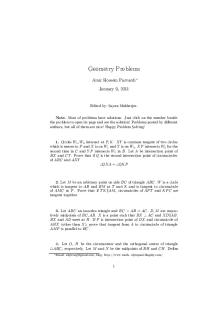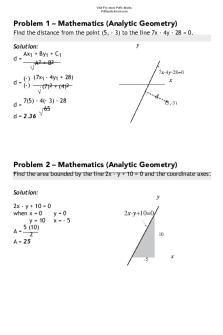Tutorial problems with solutions for Single Degree of Freedom Problems PDF

| Title | Tutorial problems with solutions for Single Degree of Freedom Problems |
|---|---|
| Course | Dynamics and Control |
| Institution | De Montfort University |
| Pages | 9 |
| File Size | 189.1 KB |
| File Type | |
| Total Downloads | 85 |
| Total Views | 137 |
Summary
Tutorial questions very similar to exam questions with solutions and answers....
Description
Tutorial problems with solutions for single-degree-of-freedom vibration: 1. A machine of mass 500 kg is supported on spring mounts which deflect 3 mm under its weight. It is found that the amplitude of free vertical vibrations is halved for each successive cycle. When the machine is operating there is a vertical harmonic force due to imbalance whose magnitude varies as the square of its frequency. The resulting amplitude of forced vibration is 2.25 mm at 10 Hz. a) Determine the magnitude of the imbalance force at 20 Hz, which corresponds to the maximum machine speed; b) Determine the greatest amplitude of vibration which may be experienced by the machine when running up to speed (Answer: 4.7kN; 2.71 mm). Solution 1: a. Static displacement of spring mounts in static conditions equals to δ=3 mm or 0.003 m . This allows us to calculate the natural frequency
ω 0=
√ √
g 9. 81 = =57 . 18 rad / s δ 0 . 003
b. From observation of free vibrations we know that each successive cycle the amplitude of vibration is reduced on fifty percent, this allows us to use the logarithmic decrement formula for calculating damping factor parameter
ln
()
a1 2 πξ = a 2 √1−ξ2
And we need to solve the following equation to express the magnitude for
ln (2 )=
6. 28 ξ
ξ
√ 1−ξ
√ 1−ξ
2
or
2
=
ξ
ln(2 ) =0.11 6. 28
Exact solution for damping factor is:
ξ=
0 .11
√1+0. 112
= 0. 1093≈0 .11
c. In operational conditions the excitation periodical force due to rotating imbalance mass is proportional to the square of rotation rate. At frequency f=10Hz the resulting steady state amplitude of vibration equals to 2.25mm (or 0.00225m). This allows us to calculate the frequency of external periodical force ω and the mass-displacement product exciting vibrations “ me ”:
ω=2πf =6 .28∗10=62. 8rad / s d. The frequency ratio r equals:
r=
ω 62 .8 =1 .1 = ω 0 57 .18
e. For dynamic imbalance excitation we have formulae for magnification factor (case 2): 2
MF=
2 r MX 1. 1 = = =3 .57 me √(1−r 2 )2 +( 2ξr )2 √(1−1 . 12 )2 +(2∗0. 11∗1. 1)2
and we can express the magnitude me : me=
MX 500∗0. 00225 =0 .315kg*m = 3 .57 3 .57
d. Now we are ready to determine the magnitude of the imbalance force at 20 Hz, which corresponds to the maximum machine speed: 2
2 2 Fimbalance =meω =me∗( 2 πf ) =0 . 315∗125. 5 =4969 . 2N
The maximum amplitude of vibration will be at resonance conditions:
( MX me )
≈
resonance
1 1 =4 . 55 = 2∗ξ 2∗0 .11
so X max =X resonance=
4 . 55∗me 4 . 55∗0 . 315 = =0 . 0029 m M 500
2. Anti-vibration mounts are used to attach an instrument of mass 2 kg to a panel. The panel is vibrating with an amplitude of 0.5 mm at a frequency of 50 Hz. Show that the maximum stiffness of the mounts for them to have any useful effect in reducing the vibration of the instrument is about 100 kN/m. If the mounts used have an effective stiffness of 20 kN/m and also provide viscous damping with a damping coefficient of 80 Ns/m calculate the maximum acceleration to which the instrument is exposed (Answer: 8.8 m/s2). Solution 2: a. This is the Case 3 of periodical excitation with the following formula for magnification factor (case 3):
√
1+(2 ξr )2 X = Y (1−r 2 )2 +( 2 ξr )2 b. Amplitude of panel vibration Y =0 . 5 mm=0. 0005 m . MF=
c. The isolation effect will take place, when frequency ratio will exceed some value
r=
ω >√ 2=1 . 41 ω0
This inequality allows us to formulate requirement for the natural frequency
ω0 <
ω0
:
ω 1.41
or
√
or
k...
Similar Free PDFs

Problems for tutorial session
- 5 Pages

150 Geometry Problems With Solutions
- 23 Pages

Tutorial-4 - Tutorial Problems
- 3 Pages

Problems for quiz2 2019 solutions
- 18 Pages
Popular Institutions
- Tinajero National High School - Annex
- Politeknik Caltex Riau
- Yokohama City University
- SGT University
- University of Al-Qadisiyah
- Divine Word College of Vigan
- Techniek College Rotterdam
- Universidade de Santiago
- Universiti Teknologi MARA Cawangan Johor Kampus Pasir Gudang
- Poltekkes Kemenkes Yogyakarta
- Baguio City National High School
- Colegio san marcos
- preparatoria uno
- Centro de Bachillerato Tecnológico Industrial y de Servicios No. 107
- Dalian Maritime University
- Quang Trung Secondary School
- Colegio Tecnológico en Informática
- Corporación Regional de Educación Superior
- Grupo CEDVA
- Dar Al Uloom University
- Centro de Estudios Preuniversitarios de la Universidad Nacional de Ingeniería
- 上智大学
- Aakash International School, Nuna Majara
- San Felipe Neri Catholic School
- Kang Chiao International School - New Taipei City
- Misamis Occidental National High School
- Institución Educativa Escuela Normal Juan Ladrilleros
- Kolehiyo ng Pantukan
- Batanes State College
- Instituto Continental
- Sekolah Menengah Kejuruan Kesehatan Kaltara (Tarakan)
- Colegio de La Inmaculada Concepcion - Cebu











